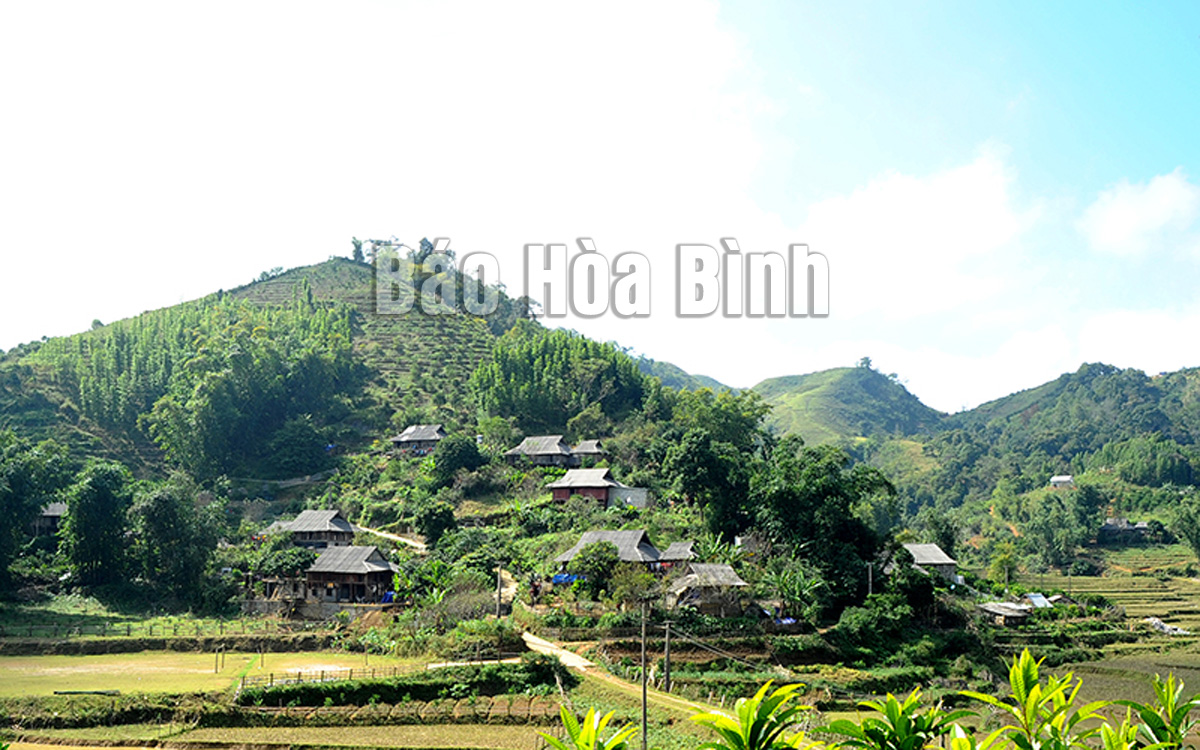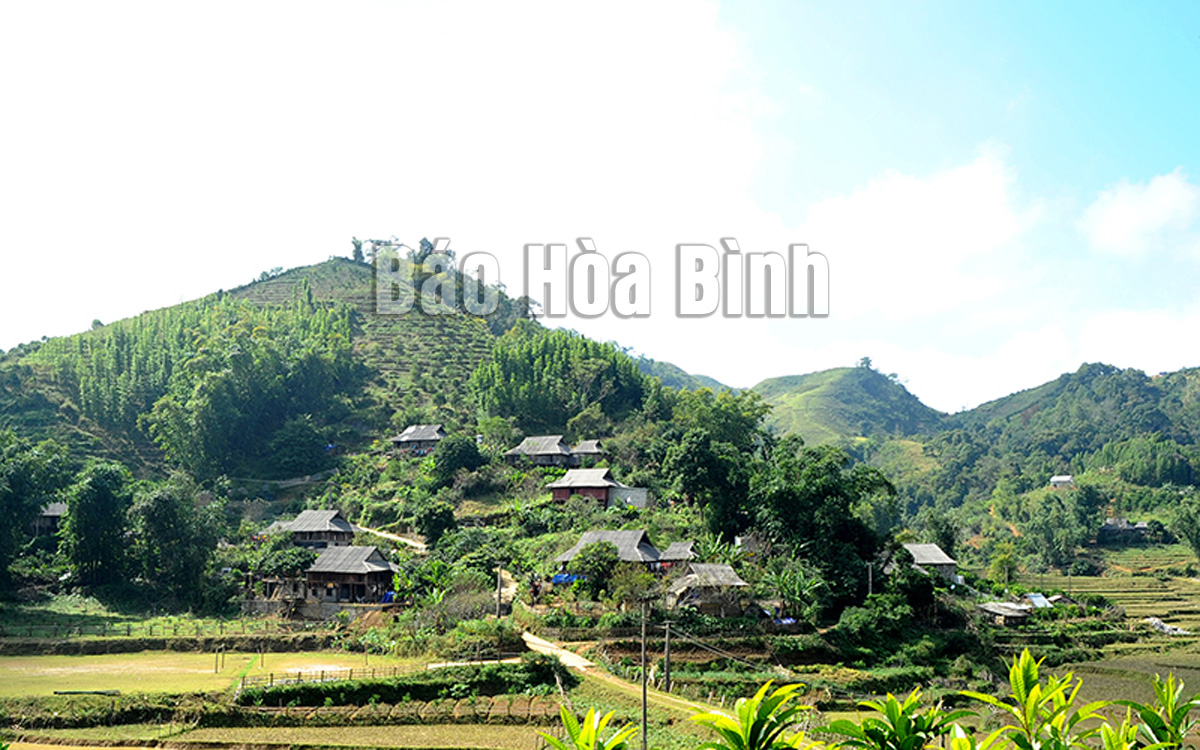



Chien hamlet, Van Son commune (Tan Lac) - a community tourism attraction, attracting tourists to explore and experience.
Along with the preferential nature, the upland community of Tan Lac district still preserves many traditional cultural values associated with Muong identity, including the ancient stilt houses, the household utensils, the costumes, the fine customs and traditions, the traditional festivals, Mo Muong performances, folk songs, folk games, cuisine... These are the resources to develop eco-tourism, community tourism, sightseeing and discovery tourism, contributing to the development of ecotourism. creating jobs, improving and raising incomes and living standards for the local people.
In the period before 2018, the tourism activities in the highland communes of the district were almost unremarkable: there were no accommodation facilities for overnight guests, no essential services for tourists; tourists were mainly from the district and the province travelling for a day. The tourism activities were mainly the natural landscapes combined with the purchase of agricultural products, some groups of young tourists, the spontaneous picnicking and unmanaged camping tourists. The total number of visitors to the communes each year was only about 2,000 - 3,000 turns of peopel, and the revenue from tourism was only 500 - 700 million VND a year.
Since 2019, the tourism activities have really started when the Australian NGO (AOP) supported the implementation of a project to improve the sustainable livelihoods through the community tourism development in the district and the selected hamlet, Chien (Van Son commune) to build a community tourism site. There are 3 households selected by AOP to pilot the homestay model, each household can serve 14-16 bedrooms.
From 2019, tourists travelling to the highland communes can stay overnight with a total number of beds sering 42-48 guests a night. In 2019, the number of visitors to the district's highland communes has significantly increased, 3-4 times higher than that of the previous years, reaching 10,300 turns of visitors, of which there were about 30% guests staying overnight, the rest are the visitors within one day, and the revenue reached about 2.5 billion dongs. In 2020 - 2021, due to the impact of Covid-19 pandemics, the number of visitors and the revenue decreased significantly compared to thoses of 2019. From March 2022, the tourism sector officially opened, entering the recovery and development phase in a "new normal state”, which is a positive signal for the upland communes of the district to continue investing, expanding tourism services, and increasing tourism attraction.
Currently, the tourism products being exploited in the upland communes of Tan Lac district are mainly community tourism, tourism associated with agriculture and rural areas and the nature-discovery tourism. The prominent one is the community tourism associated with Muong community in Chien hamlet (Van Son commune). Tourism associated with the rural agriculture and the orchards, the fields of vegetables, the off-season tubers and fruits in Van Son commune, Quyet Chien. The nature-discovery tourism associated with sightseeing, mountain landscapes, forests, caves (Nui Kien cave, Nam Son cave), waterfalls (Thung waterfall), check-in, mountain climbing, cloud hunting at Lung Van peak, exploring the nature at Ngoc Son - Ngo Luong Nature Reserve.
In recent years, the district has paid attention to developing the infrastructure for tourism, the transport infrastructure has been invested, repaired and upgraded. They are the provincial road 440 connecting national highway 6 (at Cho Lo junction). with the highland communes; the inter-district highland road from Lac Son to Tan Lac; road 312A connecting the upland communes of Tan Lac district with Mai Chau and Ba Thuoc districts (Thanh Hoa); upgrading and concreting inter-commune and inter-village roads. A number of projects developing the accommodation and the resorts in the highland communes have been approved for investment policies and they are studying for the investment proposals, including the eco-resort and nature conservation project in May valley; Lung Van Ecolodge eco-tourism resort; the eco-tourism area - community culture and nature conservation in Chien hamlet.
Implementing the project of building the upland communes in Tan Lac district so that they become a provincial tourism area by 2030, with a vision to 2050, the district is focusing on investing in a number of community tourism sites in 3 highland communes. In the immediate future, each commune chooses a hamlet to build a model community tourism site. In which, Quyet Chien commune has selected the cluster of the residential areas of old Thung village of Bac Thung hamlet; Ngo Luong commune has chosen the old Ca hamlet cluster of Luong Ca hamlet; Van Son commune has chosen Hay Duoi hamlet.
In order to effectively implement the project and exploit the potential and advantages of tourism development in the highland communes, the district has set out the following tasks and solutions: Strongly renewing the thinking and awareness of all levels, branches and localities on the effectiveness of tourism development on socio-economic development in the area; adopting the appropriate policies and mechanisms to encourage and attract all economic sectors to invest in tourism development in the upland communes; focusing on mobilizing the resources, integrating the investment capital sources to develop infrastructure, material and technical facilities to serve tourism; stepping up the promotion, publicity and development of tourism products, the development of tourism human resource; protecting the natural resources - environment...
By 2025, it is necessary to try to basically complete 50% of the conditions to recognize the district's highland communes as the provincial tourism resorts; welcoming 50 thousand turns of tourists (about 5 thousand turns of international visitors); the social revenue from tourism is about 30 billion dongs; per capita income reaches 40-45 million VND a person a year. By 2030, it is important to complete 100% of the conditions and it will be recognized as a provincial tourism area; welcoming 115 thousand turns of tourists (about 15 thousand turns of international visitors); the social revenue from tourism is about 100 billion dongs; per capita income reaches 50-55 million VND a person a year…